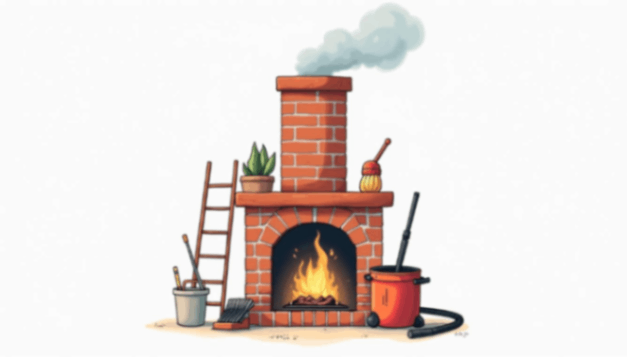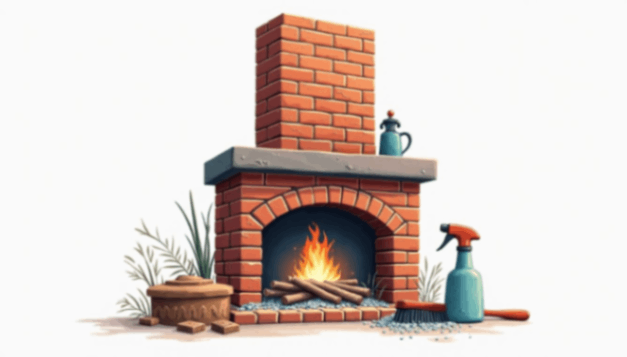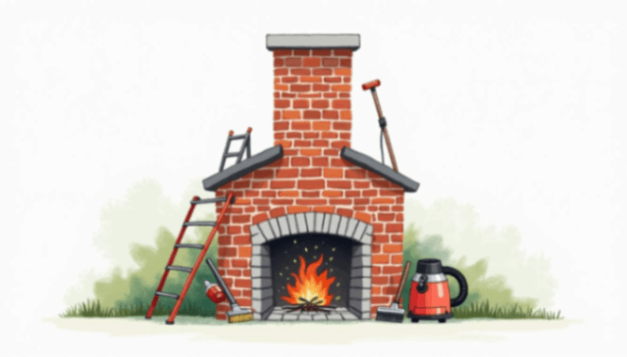Maintaining a clean chimney is crucial for the safety and efficiency of your home. Regular cleaning not only helps prevent dangerous chimney fires but also ensures that your heating system operates smoothly. In this guide, we will walk you through the importance of chimney cleaning, the necessary preparation, and the step-by-step cleaning process.
Understanding the Importance of a Clean Chimney
A clean chimney is vital for various reasons. It serves an essential role in venting smoke and gases from your fireplace or heating appliance while keeping your home safe. Understanding its importance can motivate homeowners to prioritize regular maintenance.
The Role of a Chimney in Your Home
The chimney is designed to expel smoke, soot, and harmful gases produced from burning fuel. Without a properly functioning chimney, these toxic gases can backflow into your home, posing significant health risks. Additionally, a chimney aids in airflow, ensuring that your fireplace or wood stove operates efficiently, which can help save on heating costs. A well-maintained chimney not only enhances the performance of your heating system but also contributes to a more comfortable living environment by regulating indoor temperatures effectively.
Moreover, the design and structure of your chimney play a crucial role in its functionality. Factors such as height, flue size, and material can significantly impact how well your chimney performs. A chimney that is too short may not create enough draft to expel smoke efficiently, while one that is poorly insulated can lead to heat loss. Therefore, understanding these elements can help homeowners make informed decisions regarding their chimney maintenance and upgrades.
Potential Risks of a Dirty Chimney
Neglecting chimney maintenance can lead to several dangerous outcomes. A buildup of soot and creosote can ignite, causing a house fire. Furthermore, a blocked chimney can trap carbon monoxide in the home, leading to poisoning. Other risks include reduced energy efficiency and the potential for damaging your heating appliance. Regular inspections and cleanings are essential to mitigate these hazards, as they allow professionals to identify and address issues before they escalate.
In addition to fire hazards and health risks, a dirty chimney can also lead to costly repairs down the line. For instance, creosote buildup can corrode the chimney liner, necessitating expensive replacements. Furthermore, frequent chimney fires can compromise the structural integrity of your chimney, leading to more extensive damage that might require reconstruction. By investing in regular cleaning and maintenance, homeowners can save money in the long run while ensuring the safety and efficiency of their heating systems.
Preparing for the Chimney Cleaning Process
Before you begin cleaning your chimney, proper preparation is crucial. This ensures that the cleaning process is efficient and safe. Below, we will discuss the tools you will need as well as essential safety measures to consider.

Necessary Cleaning Tools and Equipment
Having the right tools for chimney cleaning is essential. Here’s a list of what you’ll typically need:
- Chimney brush: Designed to scrub the interior of the flue.
- Extension rods: To reach high sections of the chimney.
- Vacuum: Preferably a shop vacuum to collect soot and debris.
- Drop cloths: To protect your living area from debris.
- Safety goggles and gloves: To protect yourself during the cleaning process.
- Flashlight: For inspecting hard-to-see areas.
Having these tools on hand will help make your chimney cleaning process easier and more effective. Additionally, consider investing in a chimney sweep kit that often includes specialized brushes and tools tailored to your chimney type. This can enhance your cleaning efficiency and ensure that all areas of the flue are adequately addressed, minimizing the risk of creosote buildup that can lead to chimney fires.
Safety Measures to Consider
Safety should always be a priority when cleaning your chimney. Here are some measures to keep in mind:
- Ensure that the fireplace is completely cooled down before starting.
- Wear safety goggles and gloves to protect against soot and sharp debris.
- Use a sturdy ladder if you need to climb onto the roof.
- Consider wearing a respirator or mask to avoid inhaling soot particles.
- Have a fire extinguisher nearby for emergencies.
Following these safety measures can significantly reduce the risk of accidents or injuries during the cleaning process. Moreover, it’s advisable to inform someone about your cleaning plans, especially if you are working alone. This way, someone will be aware of your whereabouts in case of an emergency. Additionally, inspecting the chimney for any structural damage or blockages before you start can save you from potential hazards and ensure a thorough cleaning. Remember, a well-maintained chimney not only improves the efficiency of your fireplace but also enhances the safety of your home.
Step-by-Step Guide to Cleaning Your Chimney
Once you have prepared and gathered everything you need, you can begin the cleaning process. Here's a detailed guide on how to effectively clean your chimney.
Inspecting the Chimney
Your first step should be a thorough inspection of the chimney. Begin by checking for visible blockages in the flue and around the chimney cap. Look for any signs of damage, such as cracks or loose bricks, which can impact performance. It’s also helpful to check your fireplace for any unusual buildup or obstructions that could affect airflow. Remember, a well-maintained chimney not only enhances the efficiency of your fireplace but also significantly reduces the risk of chimney fires, which can be devastating.
Removing Soot and Creosote
With your chimney inspected, it's time to remove soot and creosote. Start at the top of the flue using the chimney brush attached to the extension rods. Work your way down, applying pressure to scrub the walls of the flue. This process may create a mess, so ensure that your drop cloths are well-placed to catch debris. It's important to note that creosote is a highly flammable substance that can accumulate over time, especially if you burn wood that is not properly seasoned. Regular cleaning can help prevent dangerous buildups and ensure your fireplace operates safely.
Continue to scrub until the flue is clean, and don’t forget to check the area around the smoke shelf and damper where buildup commonly occurs. If you encounter stubborn spots, consider using a chemical cleaner specifically designed for chimney maintenance, but always follow the manufacturer's instructions to avoid damaging your chimney.
Cleaning the Chimney Flue
After cleaning the interior surfaces, it’s crucial to focus on the flue itself. Use a vacuum to collect any soot and debris that may have fallen. This step ensures that your chimney is clear and that air can flow freely, minimizing the risk of future blockages. Additionally, inspecting the flue liner for any signs of wear or damage is essential, as a compromised liner can lead to dangerous gas leaks and reduced efficiency. If you notice any issues, it may be wise to consult a professional for repairs or replacement.
Cleaning the Chimney Cap
Finally, check the chimney cap. This component is vital as it prevents rain from entering the chimney and deters animals from nesting inside. Clean the cap using a damp cloth or a brush to remove any dirt, soot, or debris that has accumulated. A clean chimney cap will not only improve function but also increase the lifespan of your chimney. Furthermore, consider installing a mesh screen on the cap if you haven't already; this will provide an additional barrier against wildlife while allowing smoke to escape freely.
Regular maintenance of your chimney cap can also prevent water damage, which can lead to costly repairs down the line. By ensuring that your chimney is in top condition, you can enjoy the warmth and ambiance of your fireplace with peace of mind, knowing that you have taken the necessary steps to keep your home safe and cozy.
Post-Cleaning Steps
Once you have thoroughly cleaned your chimney, there are a few post-cleaning steps to ensure everything is in order.

Disposing of the Collected Debris
It’s essential to dispose of the collected debris responsibly. Soot and creosote should be sealed in a bag to avoid any air pollution or mess. Check with your local waste management guidelines to see how to dispose of this material properly.
Checking for Any Needed Repairs
After cleaning, take a moment to reassess the condition of your chimney. Look for any signs of damage or areas that may require repair. If you notice significant issues, it may be wise to consult a professional before using your fireplace again.
Maintaining Your Chimney’s Cleanliness
Cleaning your chimney is not a one-time event; it requires ongoing maintenance. Implementing a few preventive measures can help keep your chimney clear and functioning optimally.

Regular Chimney Inspections
Schedule regular inspections of your chimney to check for blockages, damage, or other issues. Many experts recommend having your chimney inspected at least once a year, particularly before cold weather sets in. These inspections can help catch problems early and maintain a safe environment for your home.
Preventive Measures to Keep Your Chimney Clean
In addition to inspections, consider implementing some preventive measures. These can include:
- Using seasoned wood for burning to reduce creosote buildup.
- Keeping the area around the chimney clear of debris and potential blockages.
- Installing a high-quality chimney cap to prevent weather and animal-related issues.
Taking these steps can drastically reduce the likelihood of frequent cleanings while ensuring your chimney remains safe and effective.
In conclusion, maintaining a clean chimney is essential for the safety and efficiency of your home. By understanding its importance, preparing correctly, and following the step-by-step cleaning guide, homeowners can protect their families and ensure the longevity of their heating systems.










